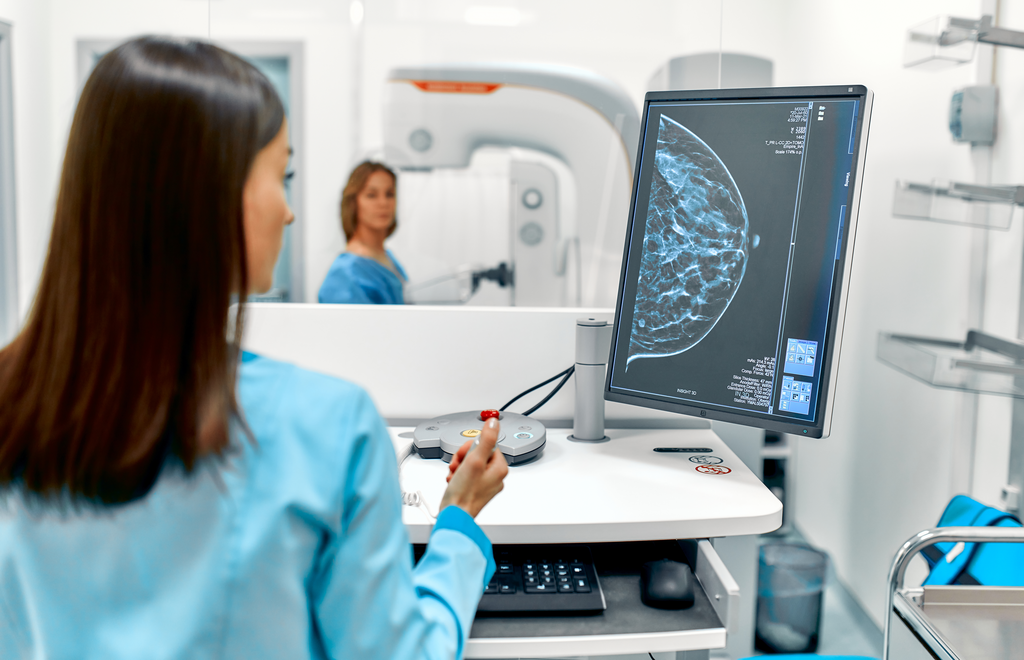Research - 22.09.2023 - 11:30
Breast cancer early detection programme save lives
For the first time, the School of Medicine and the Cancer League of Eastern Switzerland have formed a research collaboration. Data from the "donna" breast cancer early detection programme from 2010 to 2019 in St.Gallen and Graubünden were analysed. The five-year survival rate for women who participated in the programme was more than 10 percentage points higher than those who did not undergo screening. The positive overall result underscores the importance of systematic breast cancer early detection.

For the first time, the School of Medicine (MED-HSG) and the Cancer League of Eastern Switzerland have formed a research collaboration. Data from the "donna" breast cancer early detection programme from 2010 to 2019 in St.Gallen and Graubünden were analysed.
Breast cancer is the most commonly diagnosed type of cancer in women in Switzerland. It affects 6,500 women annually, with 550 of them in the cantons of St.Gallen and Graubünden. In most cases, women over 50 are affected. The "donna" breast cancer early detection programme aims to contribute to earlier detection and a more effective treatment of breast cancer. Women between the ages of 50 and 69 are invited to undergo a voluntary breast X-ray examination, known as a mammogram, every two years through "donna."
To evaluate data from 2010 to 2019 in the cantons of St.Gallen and Graubünden, and the Cancer League of Eastern Switzerland enlisted the School of Medicine (MED-HSG). Data from the Eastern Switzerland Cancer Registry and the "donna" programme documenting over 2,700 breast cancer cases were analysed. The primary goal of the collaboration was to ensure and enhance the quality of the "donna" program.
Higher Survival Rates and Less Invasive Treatments
Early detection programmes can identify cancer in its early stages. One quality criterion for effective early detection programmes is minimizing so-called "interval carcinomas," which occur between two screening examinations. If a first examination is declared unremarkable but breast cancer is diagnosed within 24 months after screening, it is considered an interval carcinoma.
The following findings are particularly noteworthy:
- Women diagnosed with breast cancer who participated in the "donna" programme had a significantly higher five-year survival rate (96.5%) than women outside the programme (86.1%).
- The significantly higher survival rates can be attributed, in part, to the fact that breast cancer was detected at an earlier stage with "donna" – it identified 64.1% of cancer cases as either in situ carcinoma or carcinoma in Stage 1. Outside the program, this figure was 43.4%.
- "donna" participants required only half as many breast cancer surgeries, known as mastectomies, and significantly fewer chemotherapy sessions.
- Women within the "donna" programme who developed an interval carcinoma within 2 years after screening still had a significantly higher survival rate than women who did not participate in screening.
- The "donna" programme has a low interval carcinoma rate in comparison to nationwide figures, confirming its high sensitivity and effectiveness.
- Interval carcinomas are particularly common in women undergoing their first mammography, those with high breast density, and those with a high Ki-67 protein value, which indicates more aggressive behaviour.
Minimizing Risk Factors and Testing AI Software
"Early cancer detection is not only beneficial for individual women but also prevents the treatment of advanced disease and thereby saves resources in our healthcare system," says Prof. Dr. Alexander Geissler, professor of Healthcare Management at the School of Medicine. The mentioned results are just the beginning, as collaborative project continues.
In the next steps, the School of Medicine's research team, in collaboration with experts from the "donna" programme and the cancer registry, will further advance the following approaches:
- Review of interval carcinoma mammograms: Mammograms where an interval carcinoma is detected are currently reviewed by independent radiologists to assess whether no or minimal indicators were visible in the previous mammogram. These results can contribute significantly to determining the program's sensitivity and serve as training material for radiologists.
- Addressing risk factors for interval carcinomas: Discussions are ongoing regarding ways to further reduce the number of interval carcinomas, particularly in women with prevalent risk factors (e.g., high breast density and high Ki-67 values).
- Utilizing AI in breast cancer diagnosis: AI software is currently being tested. If the study results are positive, it may support radiologists within the "donna" programme in interpreting mammograms. Initial international publications suggest the potential of such software applications in improving sensitivity and efficiency.
The collaborating partners recommend participation in breast cancer early detection programs like "donna" and affirm the results of previous studies outside Switzerland. In the words of Dr. med. Rudolf Morant, president of the Cancer League of Eastern Switzerland: "Join in and bring a friend; you may save her life."
Image: Adobe Stock / Valerii Apetroaiei
More articles from the same category
Discover our special topics











